How New York has moved past the James Dolan era while honoring its past and fostering a new culture.
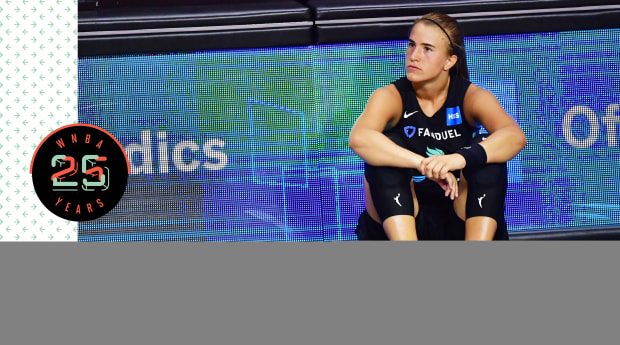
When Teresa Weatherspoon recorded the audio track that plays during the Liberty’s #OwnTheCrown 25th-anniversary campaign, she was sent back in a time warp. Weatherspoon felt 1997 in her bones when she uttered the words: “This is our court. This is our city.”
All these years later, she still knew how to perform. The way she would slide like a penguin on the hardwood floor to save the basketball or wave her arms up in the air to get the home crowd at Madison Square Garden loud when a game was on the line roared back into her brain.
“All you have to do is tell me one time: Let’s go, boom, because I’m ready,” she says about the recording process. “I was ready to work because I was fired up to do it. I was back in player mode.”
She served as a reminder of what the Liberty were always about, and what made one of the original WNBA franchises so special. Weatherspoon didn’t have to look in a mirror to remind herself of who she was 25 years ago. She is a part of the franchise for life.
In the past few years it’s been the Liberty franchise that has looked in the mirror and rediscovered what it’s about and who it serves. A change in ownership, a complete roster overhaul and now a change in where the franchise calls home were all critical phases of the rebuilding process for one of the WNBA’s premier franchises, which hasn’t reached the playoffs since 2017 and has never won a championship.
Soon after the franchise began its roster overhaul under a new coach, Walt Hopkins, the COVID-19 pandemic hit, putting a wrench in its plans to reestablish bonds with a quarter-century-old fan base.
The Liberty rebuild, both on and off the court, will be about reminding its fans that the organization still remembers what made New York basketball something to behold. Amid an evolving game, the way the Liberty will play and conduct themselves on the court will be reminiscent of where it all began.
But this new era for the organization, which begins on Friday at Brooklyn’s Barclays Center vs. the Fever, is also about capturing a new generation of fans who also identify with what makes New York, New York. The fight. The hustle and bustle. The grit and the relentlessness. The love for the game. That foundation will only push the Liberty forward.
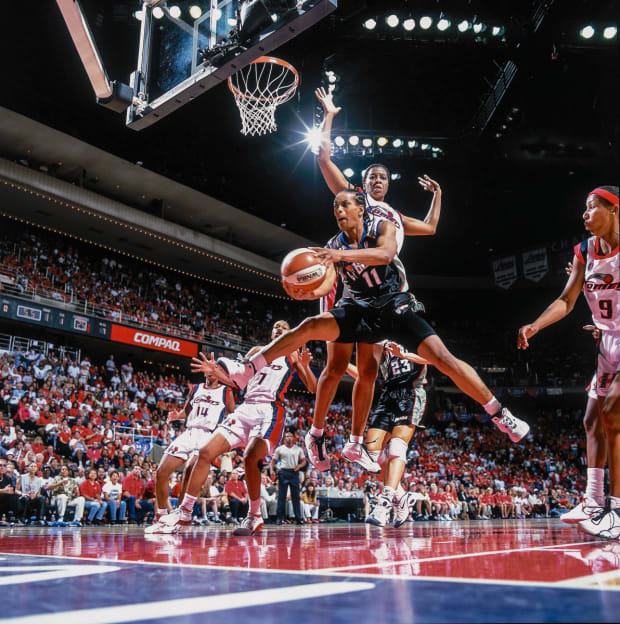
At an 11 a.m. practice during training camp, Hopkins stops a five-on-five taking place. Former player turned assistant Jacki Gemelos gathers the two balls in play, stopping their bounce, and longtime Hopkins collaborator Shelley Patterson scampers from the other side of the practice court to meet everyone on the opposite side. “Hey, listen up,” Hopkins shouts.
“Listen up, something can never happen again: We didn’t sprint back on defense. There was a missed layup and if anyone would have run, we would have had a rebound. Instead we gave up another shot.”
The Barclays Center’s practice court, where echos aren’t absorbed, is silent. Heads bobbed up and down, taking in everything Hopkins had to say. Players agreed with what he had just observed.
“A missed layup should turn into a bucket for us [he points to the opposite basket], not a bucket for them. Quick drink, let’s go.”
Circled around the top of the restricted area, every player maintained eye contact with Hopkins as he spoke. There were no distractions—unlike in previous years.
When center Kiah Stokes was drafted by the Liberty in 2015, she couldn’t wait to play in what she deemed one of the best cities in the world. When she came to New York, the Liberty had a competitive roster. They won a franchise-best 23 games that season with a team including Tina Charles, Epiphanny Prince, Swin Cash Canal and Tanisha Wright. The team made it to the Eastern Conference finals, but dropped the series 2–1 to the Fever, anchored by Tamika Catchings with younger versions of current Liberty players Natasha Howard and Layshia Clarendon.
Flash forward three years, and the morale had plummeted.
When then team owner James Dolan announced that he was putting the franchise on the market to be sold in the fall of 2017, he moved the team out of Madison Square Garden and into White Plains’ Westchester County Center. The almost-100-year-old arena could house fewer than 5,000 fans. Its locker rooms forced players to climb several flights of stairs to get ready for games in a tiny room that had wooden stalls squashed together. Getting dressed and undressed in a room that was made for high-school-sized bodies, Liberty players felt slighted, as did their fans.
Die-hard Liberty fans not only felt disrespected but were apprehensive that they were going to lose their team. Some thought maybe the team would relocate to another city, like Boston or Philadelphia, and others catastrophized. Could the Liberty’s story end? Would they have to fold like the Houston Comets, their former rival and the winner of four straight WNBA championships?
The announcement of the sale, the move to Westchester and the change from coach Bill Laimbeer to his top assistant, Katie Smith, was too much change too quickly. Even the Timeless Torches, the dance troupe of people over 40, couldn’t motivate Liberty players. Playing in a high school gym led to a lack of motivation, and a lack of motivation led to a lot less winning. “It was just all just a mess, and I felt like all the pieces just fell down,” Stokes says. The roster wasn’t on the same page. Previously, the only solution to internal problems was to go out and win.
From the outside looking in, two-time WNBA champion and new Liberty guard Sami Whitcomb notes that the organization wasn’t able to treat its players “professionally” in the final years of the Madison Square Garden Company’s ownership of the team.
More than a year later, New York was bought by a new ownership group, led by Joe Tsai, executive vice chairman of Alibaba, and his wife, philanthropist and businesswoman Clara Wu Tsai. For the pair, women’s sports are personal. They have a daughter who currently plays varsity lacrosse for the Stanford Cardinal. “I really want to support women’s sports because I think young girls need role models to look up to,” he told ESPN in May 2019. For both, owning the Liberty is more than just about owning a basketball team. They both love basketball, but they also aspire to see more women succeed in leadership roles around the world.
Fans could breathe a temporary sigh of relief. The team wasn’t going anywhere, but that didn’t mean it didn’t have work to do. The roster was disjointed, and it had a franchise player in Charles who wanted to win now but didn’t have the proper tools around her. She didn’t have time to endure a rebuild. Even with the new ownership, the die-hard fans, or the Lib Loyals, still had to take trains and buses and travel leaps and bounds just to see their team. Some were still dedicated, but others were slowly growing a little restless.
CEO Keia Clarke and general manager Jonathan Kolb both viewed those years in Westchester and even the shortened season in the Wubble as foundational both on the basketball and business sides of the team’s operations. Clarke explained the internal reckoning: How could the franchise reemerge as a team that the WNBA and its broadcasting partners would celebrate rather than avoid? (In Westchester, the building they played in wasn’t equipped to handle the technology required for a national broadcast, so a Liberty home game wasn’t shown on ESPN for two whole seasons.)
To Clarke, building the organization back up was all about exposure and alignment. The Liberty had to reach more fans and align with sponsors and partners who supported their mission and aspirations as a progressive women’s sports franchise located in the New York metro area. When Kolb was hired in 2019, he realized he had to rectify the franchise’s ambiguous team culture and make sure his players felt respected and appreciated.
Hiring Hopkins, a 35-year-old coach who has two master’s degrees focused on how developmental psychology could be applied to coaching, represented the first step toward establishing a new and much more stable team culture. In two drafts and two free-agency periods, Kolb and Hopkins constructed a new young group that shared personality traits and that had a compatible psychological profile: These were people who had been selfless and collaborative, with a certain level of humility. Patterson was more overt when she discussed the types of players and staff that are a part of the Liberty now. “There’s not a lot of divas on this team,” she said during the team’s media day on Monday.
What Kolb & Co. were building excited Jocelyn Willoughby, one of seven rookies on the Liberty’s Wubble roster, from the jump. The team’s culture is structured horizontally and less focused on hierarchy. There isn’t a group of veteran players who have the authority to lay down the law. “It’s different in the sense that yes, we’re young, but we’re all empowered, regardless of how many years,” she says. “Of course you have to respect experience, but it’s not like you have the voiceless and the people who with voices, or strictly coaches and staff and players, you know. We’re in this together.”
Willoughby, who is out for the season with a torn Achilles, remembered how it wasn’t just the rookies who brought in the equipment bags for games in the Wubble. Veterans and even members of the coaching staff would pitch in when they weren’t even asked. That’s the type of person the Liberty targeted in drafts and offseasons.
But acquiring and signing the right people is only the first step in creating a team culture that lasts. Hopkins, Kolb and current franchise star Sabrina Ionescu all described this new team culture as still fragile.
“Once we lay down the foundation of what our team identity is, the key pieces that we’re going to have, and all the supporting people around it, it’s going to be something that’s not really going to be able to be threatened or broken,” Ionescu says.
Whitcomb, who came straight from a winning culture in Seattle, knows what the end goal looks like for the Liberty’s infantile culture. Establishing habits such as coming to practice with focus, giving 100% effort and taking proper care of their bodies outside of the gym will be key. Hopkins also understands that the accountability needed to come from not only his players but from him, as well. He’s a check on the group when morale is down. While coaching the German women’s national team this offseason, he learned that being a head coach requires him to be much more forthright than when he was an assistant or individual skills coach.
“I think one of my eureka moments was understanding how much of that structure has to come from me really clearly, really directly and really consistently,” Hopkins says.
While Hopkins is key, Whitcomb noted that everyone has to work at the culture every single day. “We can’t take days off from that and eventually, hopefully it’s just habits,” she says. “It’s all of our habits, and you wake up one day and, it’s that culture. It’s there. It’s not something that we have to constantly remind ourselves to do. We’re doing it, and that’s the culture we’ve built.”
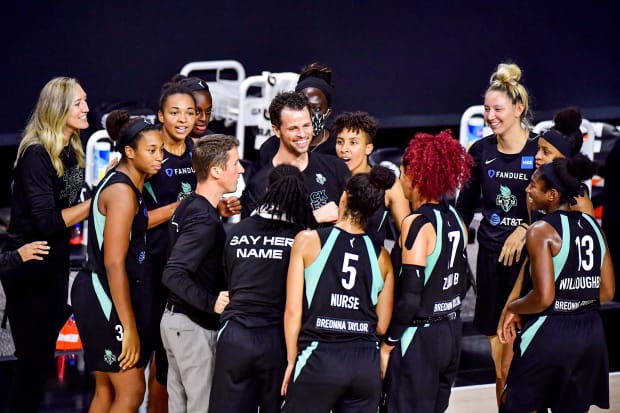
Before her third-degree ankle sprain, Ionescu showed the Liberty coaching staff a sequence that they couldn’t stop watching.
On July 31 against the Dream with under seven minutes left in the first half, Ionescu drove off a Stokes screen with then Dream and now Liberty wing Betnijah Laney following by her side. Four seconds later, Ionescu’s drive became a two close to the basket, landing in the net over Elizabeth Williams, who was trying not to foul the Liberty point guard. Once the ball left Williams’s hands, Ionescu dashed all the way down the court. By the time Laney threw a football pass all the way to the other end of the court, Ionescu had run all the way down to jump up and intercept the pass meant for Blake Dietrick.
Ionescu jumped, got her hands in front and made a volleyball set over to Clarendon while falling into a backward somersault. Clarendon began the next offensive set and pushed the ball into the paint, hauling a two over Laney. The Liberty tied the score at 25, the Dream called a timeout and Ionescu was caught on camera breathing heavily but flashing a smile.
The somersault play is what it means to wear seafoam and black.
In Kolb’s two years with the Liberty, he has thought a lot about what it means to wear New York’s colors. He characterized being a part of the Liberty as believing in sacrifice and innovation. The sacrifice piece reflects how crucial it is for all members of the organization to buy into something greater than themselves and even greater than basketball. And innovation is in direct reference to how the Liberty executed a “hybrid rebuild” that brings their young core that they drafted in 2020 and ’21 along with more veteran leaders who best fit their developing team culture and style of play.
Kolb also argues that the way the Liberty are going to play basketball is innovative, but for some very loyal Liberty fans, it might look very familiar: ball movement and gritty defense.
JoAnne Lee, a Lib Loyal since 1997, remembered the nose-to-the-ground defense that Weatherspoon and current Wings head coach Vickie Johnson used to play in the backcourt.
When asked how she felt when she heard about the Liberty’s shift to defense for the 2021 season, she replies: “It has to be.
“They’ve got to get down; they’ve got to grind,” she says. “They can’t just be lollygagging and just waiting. You’ve got to get in there and play the game, the whole game. Defense, defense, defense. That wins games.”
Lee, in addition to many other Liberty fans, isn’t even in New York. Based in Smyrna, Del., she still has her season tickets and makes an over-two-hour journey just to see the Liberty. New York has fans across the country and even all over the world. François Monroc is originally from Paris but moved to Brooklyn in 2017. He attended a Liberty game at MSG in ’01 and saw fans who roared and were as unwavering as an angry swarm of bees. His experience in the stands “fit the image” that he had of what New York fans are all about.
He might have seen two loud and loyal Liberty fans in Sandee Cohen and Terry DuPrat, who also have been following the the Liberty since the team’s inception. Cohen became a fan because she could watch women play basketball in a way that she was “never allowed to play.” Back in her day, she played with a pass every three dribbles.
Cohen remembered how a young Leilani Mitchell got her fired up in the stands. She thought that the point guard had a “spark of genius.” She remembers getting a picture with Mitchell on her birthday. She even made “leis for Leilani” and distributed them to the fans who sat in her section.
DuPrat mused that one of the most memorable parts of going to a game was how accessible players were. She felt like she just knew them. Even if the Liberty lost, the pair always had a ball. They’d find amusement when the arena DJ would play “Runaround Sue,” the 1960s doo-wop song by Dion and the Belmonts, to honor fan-favorite post player Sue Wicks when she’d return to see the Liberty after her own playing career.
As Clarke enters her 11th season with the team, she has seen this passion up close and personal. A fan once explained to her that the level of hardcore fandom displayed by Liberty fantatics is in essence the “lunch pail mentality.” Liberty fans were engaged because they saw that their players kept showing up regardless of each game’s outcome.
But that mentality wasn’t always present in the final years in Manhattan leading into Westchester, and the fans noticed. That energy began to shift and power down. Those days of the players grabbing the microphone to thank the fans for their loyalty and passion during the last home game of the regular season had faded away.
To Cohen, it was insulting and cold.
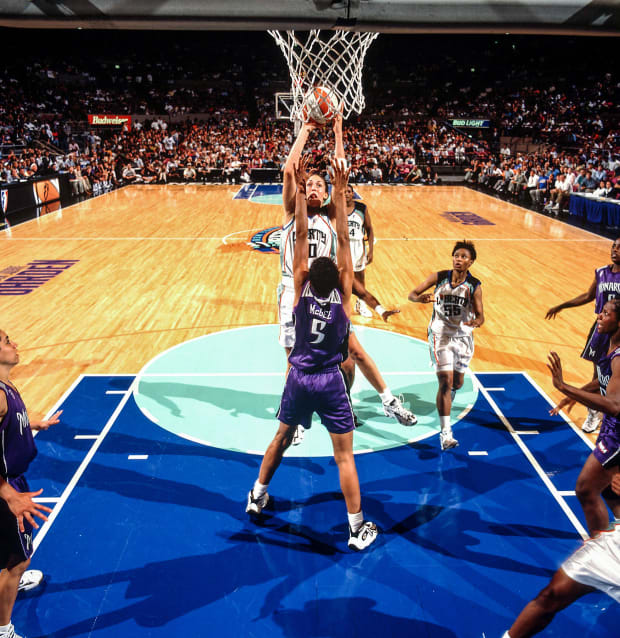
When the Liberty report to practice every morning at the Barclays Center practice court, in addition to amplified dribbles and the high-pitch cacophony of sneaker squeaks, they are greeted by something new for the franchise. Up on the padded black walls below the scoreboard, a black-and-white torch is displayed permanently feet away from the Nets’ capital B. The logos stand equidistant from the hoop they remain parallel to.
From training at the Reebok club (now Equinox Sports Club) on the Upper West Side, practicing at the Knicks’ facility in Tarrytown, using St. Joseph’s College’s facilities and lastly fighting for slots to practice at IMG Academy last summer, the Liberty finally can practice at a place where they belong.
While the Knicks’ facility replaced the hardwood floor with the Liberty’s original crest, there was no trace of recognition on the walls. Knicks logos and Hall of Fame jerseys hung up above without any acknowledgment of a torch or seafoam.
This new setup is significant. It spells out that the team owns its space at last. “It doesn't feel like we're borrowing someone’s gym; it feels like we belong,” Ionescu says.
The Liberty may have arrived, but their fans don’t really know them yet. After three seasons playing in more remote locations, they are still in the process of reintroducing themselves to the New York metro area.
COVID-19 has made that introduction anything but smooth. OG Liberty fans are in the dark about who this team really is. They’ve heard all about Ionescu as the franchise’s first and only No. 1 draft pick. But as of now, all they can remember is her injury and the team being without her for the majority of the 2020 season.
The coronavirus has “hurt the fan experience,” Cohen says. Season-ticket holders who picked their seats before the pandemic began might not even get the seats they paid for.
Willoughby started connecting with fans via her book club, Read What You Sow. While playing in Israel, she hosted the club in conjunction with Brooklyn intersectional feminist bookstore Cafe con Libros. Her goal wasn’t only to begin to get to know some of the Liberty’s fans but also to understand issues they care about and what changes are needed in their communities. She enjoyed listening to folks on Zoom discuss the month’s book while also opening up and getting personal. She was inspired.
“One thing that’s really stood out to me is that they're professional and hardworking people,” she says. “Like we have [had] many educators on the call, people who volunteer in their communities or are a servant in several capacities, and they care.”
While Brooklyn resident and French teacher Monroc couldn’t attend Willoughby’s book club, he thought the idea was a huge step in the right direction. It showed him that Willoughby “understands the community” she’ll be playing for in years to come. He also contends that playing at Barclays Center should help the Liberty rebuild their fan base considerably. “There are many talented girls living in New York playing basketball,” he said. “Can you imagine the impact it would have on them, especially in Brooklyn, to have a team?”
Ionescu imagines the impact often. She remembers how she helped grow the fan base of Oregon women’s basketball. She reveled in the opportunities to attend the practices and shootarounds and play with the young kids in the state. In just her four years in Eugene alone, attendance at games (before the pandemic) increased by 500%.
After seeing hundreds of young people on Zoom wearing her jersey during a virtual clinic this past offseason, she’s itching to get to know the younger generation in New York. They listened to her, sent her notes and questions, and tried drills on their own. They just wanted to learn, and Ionescu wants to be there for them in person just like she was in Eugene. In New York, Ionescu wants to see those familiar faces in the stands and craves for the types of bonds she built at Oregon. The return to Liberty’s home market is an opportunity for Ionescu to start doing that work.
“That gives me hope and that gives me excitement to just reach out and get out in the community finally face-to-face and talk to these kids,” she says. “And hopefully be someone that they can lean on for whatever it is they do need to, [what] they need help with.”
Ionescu is used to rebuilding something from scratch and understands how repairing these relationships take not only time but also care. Former Liberty legend and current ESPN analyst Rebecca Lobo (whose husband is a contributor to Sports Illustrated) envisions Ionescu fostering those connections she makes with New Yorkers just by being herself. As the hardworking kid of Romanian immigrants, Ionescu’s experiences and philosophies on life will resonate with the melting-pot culture in New York. And the same goes for her teammate and mentor Clarendon, who represents what is at the heart of New York. What Clarendon speaks about—social justice and trans rights—is especially important to the city.
The Liberty have the people who can communicate their values of equality, advocacy and service all in the right place. But they can’t solely rely upon touting Ionescu’s collegiate accomplishments or Clarendon’s extensive achievements as an activist and an organizer.
In unprecedented circumstances, book clubs and virtual and in-person socially distanced skills clinics have served a purpose, but on the court, the Liberty still have a lot to prove. This 25th season is about giving the fans something to look forward to and believe in, Lobo says. With a newer ownership group that is more invested in the team than ever before, the goal ought to be to give fans hope. “This year is about reenergizing the fans again,” she says. “I think they will say, ‘You know what? This franchise has a chance again.’ ”
But how? Weatherspoon has some suggestions. It begins with the players who are new to the city—which is the whole roster minus Stokes and Rebecca Allen—making a concerted effort to establish and foster a connection. Weatherspoon spoke of how fast word can travel when fans feel connected to the players that they love. Once a small group of fans are captivated, they won’t stop talking about it.
Weatherspoon viewed herself as not just a basketball player but a New York entertainer. She took it upon herself to perform for the city. The court was her Broadway stage, and jumping onto the scorer’s table was her way of taking a curtain call.
“You got to connect all the dots to make sure that every person that enters into that arena,” she says, “whether it’s the fans, whether it’s a worker in the arena, whether it’s the scorekeepers, whoever it is. They have to know that they are connected to your success. They have to know that in what you’re doing, they matter.”
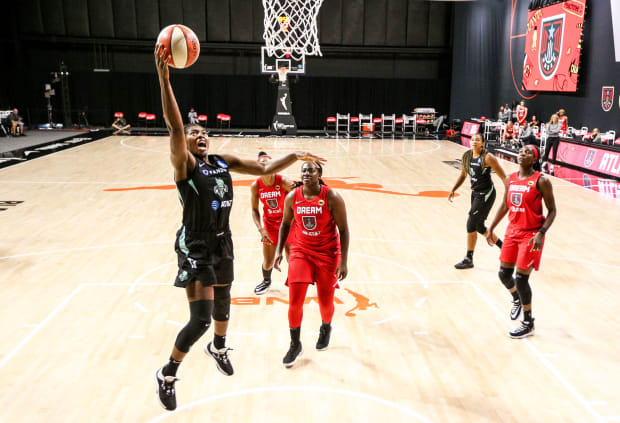
Guard Jazmine Jones tosses the ball over to coach Gemelos and gets into her defensive stance. In her neon-yellow kicks, she hops a bit over to her right to prepare for when her teammate catches the ball and starts to drive. Jones shuffles to her left and sashays with her arms spread out wide like the wings of a bird. In a split second she runs back, getting ready to guard Clarendon, the next Liberty player in line.
After Jones runs through three more of her teammates, it’s wing Asia Taylor’s turn. Her first task is Clarendon, who hesitates toward the basket. Taylor (who has since been waived) gets down low with her arms positioned like a clock set to three. She shuffles toward Clarendon, creating an airtight angle with her knee extended so far forward that Clarendon can’t advance and turns to hold their dribble. “Beautiful, A-Tay!” Hopkins shouts.
Weatherspoon believes that the Liberty’s shift of focus to defense is a return to form. The earliest iterations of the Liberty valued defense so much that they preferred beginning a game or a half on defense and didn’t mind when a tip-off began with the ball in the other team’s hands. “We didn’t mind because we were so confident in our connection defensively that it didn’t matter,” she says.
They were physical, and they took opposing teams out of their comfort zones. The Liberty’s identity was ingrained in the entire roster. It was a lifestyle: turning defense into offense at every opportunity.
Whitcomb says that defense is one of her first associations with the Liberty. To her, the team was founded on a workhorse style of basketball that was reliant upon getting stops that created that pace that fans often remember. The pace and electrifying offense were rooted in the defense. It was not only a part of Weatherspoon’s game but also it became a key component of her successor Becky Hammon, whose game fans also adored.
Hopkins’s style of play has always required versatile players who could shoot from anywhere, but after doing some offseason research including assessing the team’s new talent, New York realized that it needed more experienced personnel to lead a young group including Willoughby, Jones, Kylee Shook and Leaonna “Neah” Odom, who all have defensive potential. After adding Laney and three-time WNBA champion Howard, who are both versatile and incredibly defensively minded players, it became even clearer what the focus of the identity had to be.
“They get that that’s essential,” Whitcomb says. “They get that that would be why when this team was a team that players didn’t want to face, a team that was tough to beat, it was because they were defensively tough.”
The goal for this young team won’t be only taking care of the ball, spreading the floor and playing aggressive defense. For the 25th Liberty roster, this season is going to be about how they discover and then embody the city that they get to play for on the court.
After a three-year hiatus from playing within the five boroughs, the Liberty must be able to show New York why they matter. The Liberty need to remind their city of the role they play in New York. They need to prove why they’re indispensable.
Weatherspoon remembers that 25 years ago, she and her teammates wanted to build their team “around what New York City was all about.”
In 25 more years, will someone on this current team be able to say the same? Who will be the players who dive, slip and slide for all the loose balls? Who will be the players who leap onto the scorer’s table? And who will be the players who can say they gave the fans everything every single time they stepped on the floor?
When the WNBA celebrates 50 years, who will be the next former Liberty player who makes that trip through time and space back into player mode? This year we might find out.
• The 25 Greatest Moments in WNBA History
• Cynthia Cooper Is the WNBA’s Unsung Star
• How No. 1 Picks Realized a Career in the WNBA Was Possible